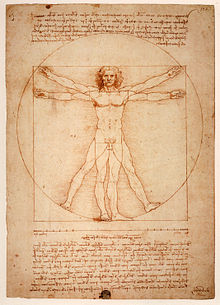
Back علوم واختراعات ليوناردو دا فينشي Arabic Ciencia e inventos de Leonardo da Vinci Spanish Science et ingénierie de Léonard de Vinci French Wynalazki i konstrukcje Leonarda da Vinci Polish Ciência e criações de Leonardo da Vinci Portuguese Изобретения Леонардо да Винчи Russian Shkenca dhe shpikjet e Leonardo da Vinçit Albanian Наука и изуми Леонарда да Винчија Serbian Leonardo da Vincis uppfinningar Swedish

Leonardo da Vinci (1452–1519) was an Italian polymath, regarded as the epitome of the "Renaissance Man", displaying skills in numerous diverse areas of study. While most famous for his paintings such as the Mona Lisa and the Last Supper, Leonardo is also renowned in the fields of civil engineering, chemistry, geology, geometry, hydrodynamics, mathematics, mechanical engineering, optics, physics, pyrotechnics, and zoology.
While the full extent of his scientific studies has only become recognized in the last 150 years, during his lifetime he was employed for his engineering and skill of invention. Many of his designs, such as the movable dikes to protect Venice from invasion, proved too costly or impractical. Some of his smaller inventions entered the world of manufacturing unheralded. As an engineer, Leonardo conceived ideas vastly ahead of his own time, conceptually inventing the parachute, the helicopter, an armored fighting vehicle, the use of concentrated solar power, the car and a gun,[1] a rudimentary theory of plate tectonics and the double hull.[2] In practice, he greatly advanced the state of knowledge in the fields of anatomy, astronomy, civil engineering, optics, and the study of water (hydrodynamics).
One of Leonardo's drawings, the Vitruvian Man, is a study of the proportions of the human body, linking art and science in a single work that has come to represent the concept of macrocosm and microcosm in Renaissance humanism.
- ^ Kaplan, E. (Apr 1997). "Anecdotes". IEEE Annals of the History of Computing. 19 (2): 62–69. doi:10.1109/MAHC.1997.586074. ISSN 1058-6180.
- ^ Innocenzi, Plinio (2018). The innovators behind Leonardo: The True Story of the Scientific and Technological Renaissance. Cham: Springer International Publishing. ISBN 9783319904481.